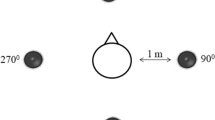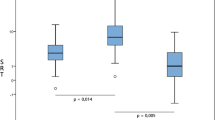Abstract
Proper production of vowels has great significance in speech intelligibility. Evidence shows that cochlear implantation has a significant impact on language and reading abilities in some children immediately after the surgery. The aim of the present study is comparing the quality of 6 simple Persian vowels between two groups of cochlear-implanted children under and over 2 years old. This was a cross-sectional analytic study conducted on 70 children who were implanted under the age of 2, 70 children who were implanted over the age of 2 and 238 normal children as control group. For data analysis, the SFS win acoustic analysis was used. Result of this study showed that F2/i/, f1/e/, f2/e/, f2/∞/, f1/a/, F2/a/, f1/o/, F2/o/and F2/u/means had significant difference between three groups (P < 0.05). Children implanted under the age of 2 showed similar performance as normal children in vowel production. Early cochlear implantation (under the age of 2) affects the quality of simple Persian vowel production significantly as well as the increase of speech intelligibility.



Similar content being viewed by others
Notes
Vibration of the vocal cords provides sound source. This sound source consists of a fundamental frequency and its harmonics that are multiples of the fundamental frequency. Then this sound is changed with shape of oral cavity. The speech cavity acts like a filter and strengthening some harmonic frequencies and weakening others. Those Frequencies that strengthened are called "Formant". Formants generally determine the differences between the vowels [20].
Speech Filing System.
References
Monsen RB, Shaughnessy DH (1978) Improvement in vowel articulation of deaf children. J Commun Disord 11(5):417–424
Higgins CM, Hodge MM (2002) Vowel area and intelligibility in children with and without dysarthria. J Med Speech-Lang Pathol 10(4):271–277
Weismer G, Jeng JY, Laures JS, Kent RD, Kent JF (2000) Acoustic and intelligibility characteristics of sentence production in neurogenic speech disorders. Folia Phoniatr Logop 53(1):1–18
Ansarin AA (ed) (2004) An acoustic analysis of modern persian vowels. 9th Conference Speech and Computer
Brown C, McDowall DW (1999) Speech production results in children implanted with the CLARION implant. Ann Otol Rhinol Laryngol Suppl 177:110
Weisi F, Rezaei M, Rashedi V, Heidari A, Ebrahimi-Pour M (2013) Comparison of reading skills between children with cochlear implants and children with typical hearing in Iran. Int J Pediatr Otorhinolaryngol 77(8):1317–1321
Archbold S, Harris M, O’Donoghue G, Nikolopoulos T, White A, Lloyd Richmond H (2008) Reading abilities after cochlear implantation: the effect of age at implantation on outcomes at 5 and 7 years after implantation. Int J Pediatr Otorhinolaryngol 72(10):1471–1478
Tomblin JB, Barker BA, Spencer LJ, Zhang X, Gantz BJ (2005) The effect of age at cochlear implant initial stimulation on expressive language growth in infants and toddlers. J Speech Lang Hear Res 48(4):853
Kileny PR, Zwolan TA, Ashbaugh C (2001) The influence of age at implantation on performance with a cochlear implant in children. Otol Neurotol 22(1):42–46
Nikolopoulos TP, O’Donoghue GM, Archbold S (1999) Age at implantation: its importance in pediatric cochlear implantation. Laryngoscope 109(4):595–599
Ryugo DK, Limb CJ, Redd EE (2000) Brain plasticity: the impact of the environment on the brain as it relates to hearing and deafness. Cochlear implants: principles and practices. Lippincott Williams & Wilkins, Philadelphia, pp 33–56
Niparko JK (2009) Cochlear implants: principles and practices. Wolters Kluwer Health, Philadelphia
Miyamoto RT, Kirk KI, Svirsky MA, Sehgal ST (1999) Communication skills in pediatric cochlear implant recipients. Acta Otolaryngol 119(2):219–224
Geers AE (2006) Factors influencing spoken language outcomes in children following early cochlear implantation. In: Cochlear and brainstem implants. Advances in Oto-Rhino-Laryngology, vol 64. karger, basel, p 50–65
Vick JC, Lane H, Perkell JS, Matthies ML, Gould J, Zandipour M (2001) Covariation of cochlear implant users’ perception and production of vowel contrasts and their identification by listeners with normal hearing. J Speech Lang Hear Res 44(6):1257
Fishman KE, Shannon RV, Slattery WH (1997) Speech recognition as a function of the number of electrodes used in the SPEAK cochlear implant speech processor. J Speech Lang Hear Res 40(5):1201
Blume SS (1999) Histories of cochlear implantation. Soc Sci Med 49(9):1257–1268
Tye-Murray N, Spencer L, Woodworth GG (1995) Acquisition of speech by children who have prolonged cochlear implant experience. J Speech Lang Hear Res 38(2):327
Harrison RV, Gordon KA, Mount RJ (2005) Is there a critical period for cochlear implantation in congenitally deaf children? Analyses of hearing and speech perception performance after implantation. Dev Psychobiol 46(3):252–261
Peterson GE, Barney HL (1952) Control methods used in a study of the vowels. J Acoust Soc Am 24:175
Ladefoged P, Johnstone K. A course in phonetics. www.CengageBrain.com. Accessed Nov 2013
Huckvale MA. Speech Filing System-SFS
Svirsky MA, Robbins AM, Kirk KI, Pisoni DB, Miyamoto RT (2000) Language development in profoundly deaf children with cochlear implants. Psychol Sci 11(2):153–158
Acknowledgments
The authors wish to thank Hossein Rezaei for his help in editing the English language in our article. Also we are very grateful to the children who took part in this study. The research was supported by University of social welfare and rehabilitation sciences.
Conflict of interest
The authors declared no potential conflicts of interest with respect to the research, authorship, and/or publication of this article.
Author information
Authors and Affiliations
Corresponding author
Rights and permissions
About this article
Cite this article
Zamani, P., Rahmanirasa, A., Weisi, F. et al. Vowel Production in Persian Deaf Children with Cochlear Implant: is the Age of Implantation an Important Factor?. Indian J Otolaryngol Head Neck Surg 66, 407–413 (2014). https://doi.org/10.1007/s12070-014-0727-1
Received:
Accepted:
Published:
Issue Date:
DOI: https://doi.org/10.1007/s12070-014-0727-1




